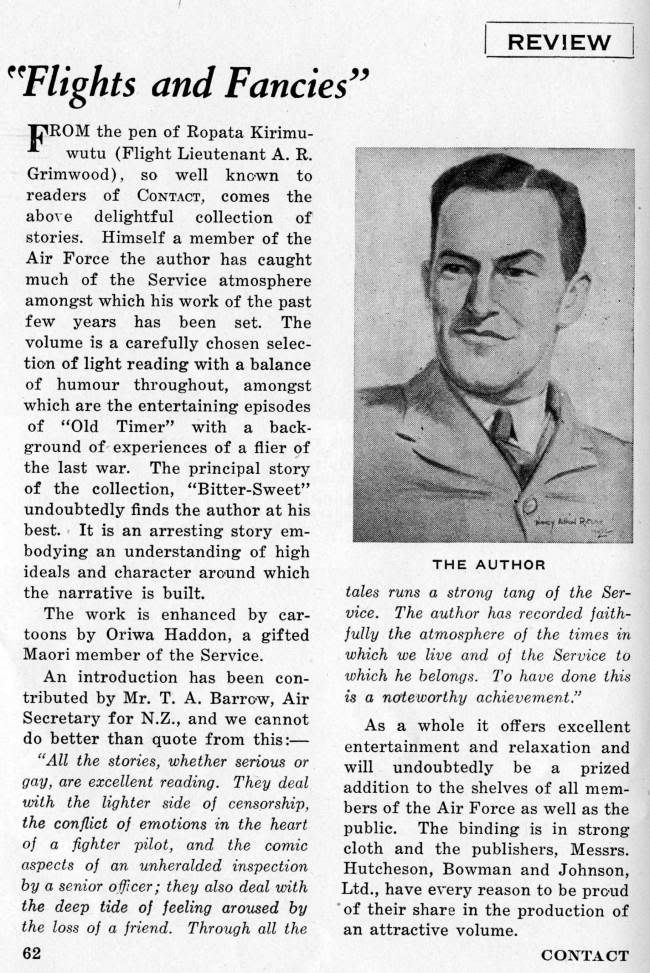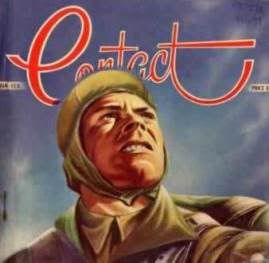
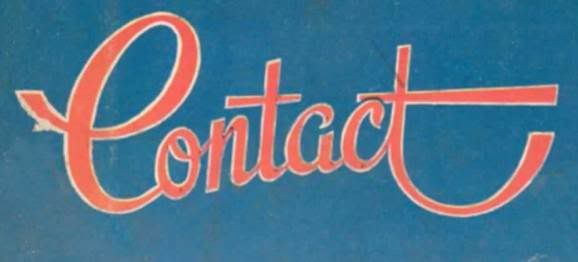
The National Magazine of the
Royal New Zealand Air Force
Index
Please navigate this section by clicking on the different areas here
- Contact - The History of the Magazine
- Other RNZAF Social Publications
Contact - The History
By Dave Homewood
with the valued assistance of Rod Mackenzie
Contact - a word that conjures up many a memory for ex-wartime airmen and women, and not just because it is shouted when starting an aircraft's engine. Contact was also the name of the popular National Magazine of the Royal New Zealand Air Force. Today the magazine is rather sort after by many as a collector's item, and it provides a nostalgic glimpse into the social side of RNZAF history. Here on this page I hope to present a history of how the magazine came about, how it developed and who was involved.
Contact - The Beginning
On the evening of the 30th December 1940, half a dozen members of the Air Force met at RNZAF Station Levin to form a committee under the chairmanship of Squadron Leader Sinclair, then Levin's Commanding Officer, with the intention to inaugurate a Station Magazine. It was to become known as Contact, and grow into a social journal that recorded all sorts of things of interest to RNZAF personnel - including news, short stories, poetry, profiles of famous airmen, sport, topical articles, handy hints, public notices and jokes. The idea had been conceived by Leading Aircraftsman J. Warren-Jones, who was to become Contact's first editor.
The purpose of this new magazine was set out in the first issue, and echoed through consecutive editions, "Contact is dedicated to Victory", and the message to all stated the mission was "...that we must work and fight to the uttermost until the day when victory is won and we can then, please God, dedicate 'Contact' not to Victory but to Peace."
The First Issue
The first issue of this monthly magazine was released in March 1941, when 2000 copies were printed at RNZAF Levin. Each issue sold for threepence a piece. Contact's first office had been set up in a room in the western end of No. 1 Mess, RNZAF Station Levin, overlooking the parade ground where many ceremonial passing out parades were carried out.
This first issue was distributed only to Levin personnel. By issue two in April 1941 distribution now also encompassed RNZAF Station New Plymouth and by June 1941 the readership had stretched to a third station, RNZAF Ohakea.
Contact soon caught the imagination of the Air Force personnel, and by August 1941 the circulation was up to 6000 issues, thanks to the co-operation of New Plymouth and Ohakea assisting in the production, and from this edition onwards it was distributed to all RNZAF Stations across New Zealand. By this time it had lost its originator and editor, as LAC Warren-Jones had left the magazine circa. July 1941 to go on active service.
With the increased circulation, a brief history of the magazine was printed in the editorial of the August 1941 issue of Contact which recognises the magazine's increasing importance"
"First it belonged to the Levin Station; then New Plymouth and Ohakea joined in to give it a completeness it hitherto lacked. It now incorporated the Initial Training Wing, an Elementary Flying School, an Intermediate and Advanced Flying School. But it still lacked something. "Contact" dealt with air crews only - with those who fly, navigate and protect the aircraft in the air. It did not deal with the training of ground staff; it did not deal with the Air Force in its entirety. "Contact" now lacks nothing in this respect. "Contact" is to deal with the whole of the Royal New Zealand Air Force."
Other Publications
Interestingly, at this time Contact was not the only station magazine in the RNZAF, and its nationwide spread was seeing it move into the territory of several other independent station magazines. These included the following (click on their names to see more):
"Spitfire" (produced at RNZAF Station Rongotai)
"Windsock" (produced at RNZAF Station Woodbourne)
"Erks' Work" (produced at RNZAF Station Ohakea)
"Taieonautics" (produced at RNZAF Station Taieri)
"The Airman" (produced at RNZAF Station Whenuapai)Little is known by me yet about Spitfire, Windsock, Erks Work and Taieonautics, but The Airman was a monthly tome that actually preceded Contact, the first issue being released in December 1940. If anyone out there has more information on Spitfire, Windsock, Erks Work, Taieonautics or The Airman I'd love to here from you. Please email me.
RNZAF Station Wigram apparently did not have a local magazine, nor it seems did any of the other RNZAF Stations in the Christchurch area. However, the Air Training Corp there did. It was called The Observer, and later changed to The ATC Observer. See more here
Going Nationwide
With Contact now being read across the spectrum of main RNZAF Stations from August 1941, it was decided to hold a conference at Air Department on the 4th of October 1941 to discuss establishing it as the semi-official national magazine of the RNZAF, over and above all the other localised magazines. This was agreed to and the move spelled the end of the other station periodicals.
Reasons for streamlining all the magazines into one included the fact that paper and resources to produce magazines were becoming increasingly scarce due to rationing brought on by limited importation, and I guess one national magazine was also easier for Air Department to keep a control over, so Contact become the national magazine. I'm unsure when publication ceased for the other three, but The Airman released its last edition a few weeks later in November 1941.
Contact was obviously recognised at the highest level as being not only very good for morale but also a great way to distribute information to airmen and airwoman across the country. From this time on with a better coverage and official backing it could only go from strength to strength, and the editorial staff realised their now important role within the RNZAF structure.
From six candidates who applied for the position, Leading Aircraftsman Michael Ruane, formerly of RNZAF Station Rongotai (and one of those behind the now defunct Rongotai magazine Windsock) was appointed as the new editor of Contact. The Officer-in-Charge was Flying Officer Charles Turnbull. I'm unsure if he'd previously held this position or whether he took it up at this stage of nationalising the magazine.
The Magazine Itself
Contact had begun life in a large size format of 276 x 220mm with around 48 pages. The cover was coloured, though originally not full colour, and the content was a mix of photos, stories, poetry, jokes and much more, almost all of which was contributed by serving Air Force personnel. The reading material that was contained within ranged from true aerial adventures to romanticised fictional stories of the RNZAF and RAF; from technical data on the latest aircraft or weapons (usually published long after they'd first gone into service) to biographies of well known RNZAF personnel and other aviators; and there were more poignant pieces such as medal gazettes and obituaries.Passing Panorama was to become a regular feature that held snippets of news and interesting facts from around the Air Force world, both at home and abroad, and Stand Easy became a regular column of jokes and cartoons. Often the powers that be of the RNZAF released political or morale-boosting statements and articles through the magazine too.
There were sections that reflected a more personal slice of RNZAF life too, that individuals could relate to such as gossip from around the bases, and personal announcements such as Air Force engagements and weddings. Some items that were thought to be then simply items of trivial interest have actually recorded fascinating snippets of history, for example a report on the first baby ever born at RNZAF Ohakea, or a photo of a VC winner's wife receiving his posthumous medals. And of course you cannot detail the content of Contact without mentioning the advertisements. There were lots of them, and they usually had some sort of slant towards the RNZAF. Today they're all in themselves a slice of social history and, for some, nostalgia.
Artwork
The original Contact artist was Leading Aircraftsman Peter Renai, who'd been with the team from the first issue. However, after a handful of issues he decided to remuster to aircrew and another artist was needed. So, near the end of 1941 another young airman joined the Contact team to take Renai's place. He was Leading Aircraftsman Robert Maurice Conly. Fate brought Maurice to Contact after he'd suffered the disappointment of being dismissed from his pilot training following a burst air drum.
With a talent for art, he soon settled in as resident artist for the magazine. Conly's first Contact cover appeared on the December 1941 issue, featuring his very nice drawing of a Lockheed P38 Lightning fighter - an aircraft very new to New Zealander's eyes at that time. Conly continued to create the covers for Contact from this point and they got more and more lavish in colour. He soon developed a wonderful style that would see his career continue for decades as Official Artist to the RNZAF, and also see many of his designs appear on New Zealand stamps and coins.
Moving With The Times
A shuffle in the organisation of the RNZAF saw the Initial Training Wing leave Levin and re-establish itself in Rotorua in January 1942. With this move, Contact also made it's first move. Between the January and February 1942 issues the Contact team moved from RNZAF Station Levin to a vacant shop in Hinemoa Street, in the centre of Rotorua. Here the team of five, consisting of Maurice Conly, Sergeant Michael Ruane (still the editor), WAAF Darry McCarthy (the sub-editor), Sergeant T. Murray (the accounts clerk) and a WAAF typist set up a nice little HQ for themselves. It was even visited and inspected by the New Zealand Governor-General, Air Marshall Sir Cyril Newall on one occasion, accompanied by the Chief of Air Staff, Air Vice-Marshall Goddard.
With the April-May issue of 1942 the format of the magazine evolved, seeing it become more compact 'digest' size. It had been proposed on the 13th of April 1942 by Flying Officer Turnbull that the size change be introduced because of the paper shortage. However, though smaller in dimensions, this move was not detrimental and in fact became an advantage because Contact actually now had more pages with more written material. The only detriment was to the quality of the paper, being a little less glossy and rich in the smaller version.Meanwhile productions costs had risen too and this forced up the price to one shilling per issue to cover these costs. Soon each issue would have an average of 80 pages per issue. The following notice appeared in the April-May 1942 issue:
NOTICE TO READERS
Readers will have noted that the price of the new "Contact" has been raised to one shilling and the magazine reduced to "Digest" size with an accompanying increase in the amount of material and the number of pages. Vastly Increased costs of production, especially in regard to paper, have been responsible for the change in price. It is believed, however, that there is no magazine on the market in New Zealand to-day that offers so much value for for so small an expenditure. The reason for the coupling together of the April and May issue was an unfortunate delay in the delivery of a shipment of paper. However, "Contact" will in future appear regularly at the beginning of each month. It is advised that the new rates will not apply to current subscribers. New subscriptions will be charged at 13/- post free for twelve issues, with a reduction to 10/- to members of the Armed Services.
There was still the problem however with paper supply, due to wartime paper shortages across the board, so this meant that occasionally editions of Contact were published combining two months into one issue because of delays in the shipment of paper.
This same April-May 1942 issue saw many of the regular features of Contact introduced, including Egbert The Erk, Wendy the WAAF, and contributions by Nimbo Stratos, Gropes and Supercharge.
With full coloured Maurice Conly paintings on the cover, each and every one more evocative than the last, the magazine was a surefire success. He was to tour the country constantly sketching and painting the scenes of the RNZAF, and its personnel.
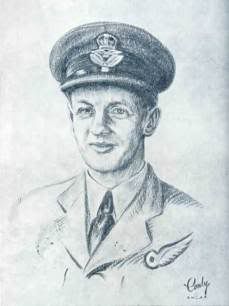
In June 1942, Officer-in-Charge of Contact, F/O Charles Turnbull, was posted to No. 8 (General Reconnaissance) Squadron at Gisborne as a Navigator, and he was succeeded in the role by F/O Bob Grimwood. Th latter was already well known to readers for his contributions to Contact under his pen-name of Ropata Kirimuwutu (a Maori version of his English name).
Tragedy struck on the 12th of December 1942 when former OC F/O Charles Neville Turnbull, NZ401448, was killed when the No. 8 (GR) Squadron Vickers Vincent aircraft disappeared without trace on a coastal patrol.
Left is a portrait done by Maurice Conly of Flying Officer Turnbull, which appeared in the July 1943 issue of Contact with an obituary written by Turnbull's successor and mate Bob Grimwood. By this time Grimwood had moved on from Contact again having been transferred to Air Headquarters in October 1942, after overseeing just three issues of the magazine.
F/O Grimwood was succeeded by F/O Herbert Mountfort, who would remain in charge of the magazine unit till his demob in August 1945.During almost two years based in Rotorua, the magazine flourished and the Contact team expanded to at least ten people, including those mentioned above and WAAF Corporal Frances Gresham (who in 1945 became Mrs Maurice Conly). According to Contact itself in the December 1945 issue, during this time the magazine "became the faithful companion to thousands of trainees as well as a good friend to many members of the civilian community." It also described the Rotorua days as Contact passing "from the spring to the summer of its life".
The Regular Contributors
As well as many one-off contributors, the magazine established several regular columnists and contributors, some serious, some humorous and some downright bizarre. In some cases the humour of the day has definitely not stood the test of time, particularly the topical stuff, but happily most of it still rings true today.
Some used their real names, like Flying Officer Winton Keay, or Squadron Leader J.A. Sherrett RCAF who contributed articles from Canada's point of view. However most regular contributors seldom got proper billing, the writers instead preferring to use a pseudonym. They include the following:
Pseudonym Real Identity if Known Notes Ropata Kirimuwutu
Egbert the Erk
Flying Officer "X"
Geoffrey Dagoc
W.2126
W.2126
Truman Warsop
I.J.M.
uncredited
"VAUGHN"
Gropes
A Headquarters WAAF
"Supercharge"
A/P
Andrew Robertson Grimwood
Max Rogers
H.E. Bates
Geoffrey Conly
Doris McLean
Doris McLean
Geoff Bentley
Ian Main
Leo White
______________?______________
Kennedy Charles (Ken) Wallace
?
?
?
A C.O. of Contact & regular contributor
Egbert was a comedy character
Worked for the RAF
Sometimes billed as just DAGOC
Formerly with the NZ Woman's Weekly
As above
An RNZAF War Correspondent
RNZAF Official Photographer
An RNZAF Observer
________________________________
A/P wrote tongue-in-cheek stories
Ropata Kirimuwutu
Flight Lieutenant Andrew Robertson Grimwood, known as Robert, wrote under the Maori verion of his name, Ropata Kirimuwutu. He was born on the 8th of January 1907 in Auckland, and died on the 6th of June 2001 in Lower Hutt. After WWII Robert served in J Force.
Flying Officer "X"
The mysterious pen name of Flying Officer "X" was in fact a well known British writer employed by the Royal Air Force especifically to write Air Force related short stories to help to raise morale. He was none other than H.E. Bates, of "The Darling Buds of May" fame. So his stories were not specifically RNZAF related but certainly connected with the many thousands of New Zealanders serving in the RAF, and their families.
Truman Warsop/Geoffrey Bentley
Geoff Bentley wrote his first fictional short story for Contact under his own name, which he described as not that great. He then began to contribute war news and articles through his job as official war correspondent for the RNZAF. He chose the pseudonym Truman Warsop. Truman was his uncle's name, and Warsop his mother's maiden name. Geoff says, "Most of my stories for Contact magazine were not attributed but some did carry an acknowledgment to "RNZAF Official News Service". I don't think I used the nom-de-plume Truman Warsop very often in Contact but mainly in the illustrated weeklies and in the NZRSA Review which I wrote for over several years."
Geoff worked closely with Maurice Conly, both in New Zealand and touring the Pacific together seeking news for Contact and for newspapers through the New Zealand Press Association. On occassions Geoff travelled to Rotorua to help Maurice and the others at Contact to "put the magazine to bed", as they say.
He continues, "I recall doing an illustrated feature on Brents Hotel in Rotorua serving as a convalescent depot for RNZAF personnel; I spent 3 or 4 weeks there and it was one of the most interesting phases of my Service career. I went there initially with Maurice Conly and we found that his brother Geoff was an "inmate" there, having to recover from a spinal operation for a slipped disc. You'll see the feature in one of the volumes of Contact."
Geoff also recalls who regular contributor IJM was. He says, "IJM was Ian Main, never a war correspondent but a good journalist and a stalwart of the directorate of Public Relations in wartime. Ian was a fine man and we were closely associated in peacetime from 1950 to 1980. Ian was Publicity Director for the NZ National Party after the war and editor of its newspaper "Freedom". Later he became PRO for the NZ Manufacturers Assn and later still was a PR consultant with Hugh Sumpter & Associates at which period I was managing director of Geoff Bentley & Associates, in partnership with my wife Nyra. (1971-1987)."
Egbert The Erk
Max Rogers, who created the classic character Egbert the Erk, was actually a was a Flight Sergeant who's trade was Clerk GD .
Wendy the WAAF/W.2126
And both the comedy character Wendy the WAAF, and the more serious W. 2126 who wrote Diary of a WAAF, was Doris McLean. She was a real WAAF, who was a Mess Steward based at RNZAF Station Anderson Park in Wellington.
The others who used false names may well have been all regular staff members on the Contact team, or official war correspondents, but we may never know as all the team's records were either given away or destroyed after the war. Many other items would be signed by people claiming to simply be 'A Headquarters WAAF', or 'An A.T.C. Headquarters Training Officer', etc. Anonymity seemed to be the order of the day.
Contact was also renowned for its excellent photographs that depicted, usually in a series, various aspects of RNZAF life and the work that the personnel carried out. It is no surprise to learn, though unaccredited, that most of the photos were taken by a young airman by the name of Leo White, who before the war had been a popular journalist and photographer. Leo spent the first few years of the war as an Army Territorial whilst continuing in his photographic business Stewart & White Ltd.
But wartime shoratges in photographic material had seen Leo White and Frank Stewart's business close, and Leo joined the RNZAF in February 1942 as an RNZAF Official Photographer. Leo built up an enormous archive of photos of the RNZAF in New Zealand and throughout the Pacific. He eventually became a Flying Officer. Leo also wrote the book 'Fighters', about the RNZAF Fighter Wing in the Pacific, during this time. Leo was transferred to the RNZAF reserve in January 1945, and soon resumed his writing, photography and publishing career. He went on to found White's Aviation magazine (1945 - 1971), New Zealand Flying (1941 - 1951) and White's Aviation Directory (1947-1988). He truly established himself as one of NZ's best aviation photographers and aviation writers. Leo died in 1967.
Another Contact team member whilst at Rotorua was AC1 Sam Jecks, who was a Clerk (General Duties) and looked after administration.
Another Move
In February 1944 the team moved again, this time to RNZAF Station Rongotai in Wellington, where their offices were set up in the ex-Centennial Exhibition buildings. The Centennial buildings had previously in 1941 been taken over for an RNZAF training centre where the Technical Training School had been situated before moving to Nelson. On the schools departure, de Havilland's aircraft factory had begun using the buildings for their production line of Tiger Moths. The buildings also had other RNZAF units including the Wellington RNZAF Recruitment Office.
This move to Rongotai was however, according to the December 1945 issue, when "the magazine, without knowing it, passed into autumn days". The tide of the war had turned, the Allies were winning, and that ultimate victory that Contact had striven for was well and truly on its way.
In October 1944 now-Sgt Maurice Conly was sent up to the Pacific to cover the war up there for Contact.
A further move for the team was necessitated when RNZAF Station Rongotai closed, and the team moved into an office at 33 Johnston Street, Wellington. Shortly afterwards, the now-Flight Sergeant Michael J. Ruane, editor, was posted to the Air Department, and subsequently to overseas duty.
Contact remained in Johnston Street till after VE Day, and then moved in July 1945 one final time, to another office at 27-29 Panama Street, just two blocks away. It was during this latter part of the war that the magazine had turned its attention mainly to the efforts of the RNZAF in the Pacific, and both Conly and Mountfort made trips into the Pacific to report in words and pictures the war of the Pacific boys.
PRINTING
The earliest issue I possess is from September-October 1941, and that issue was printed by Hutcheson, Bowman & Johnson Ltd., who were printers in Wellington. This was while the Contact office was still situated in Levin. Later whilst the Contact office moved about the country several times, the printing appears to have always been done in the same place from 1942 through to the magazine's demise in 1945. This was the "Morning Post" Printing Office in Rotorua. I'm sure this printer took on the job after the office moved from Levin to Rotorua in January-February 1942.
DISTRIBUTION
The monthly distribution had continued to climb from its inception. In April 1942 it reached 9,500 copies. Between May and October 1943 there were successive increases to 11,000 issues in circulation. This increased to 12,000 in April 1944, and 14,000 in May and June of 1944. The circulation peaked in October 1944 when it reached 15,000 copies of that month's issue. From that time on the circulation remained steady at between 13,000 and 14,000 issues. By 1944 its overseas circulation was reaching the Pacific, India, the Middle East, the USA, Canada, Great Britain and even Russia.
All of the distribution, packaging, marketing and even accounting had been handled by the Contact team members themselves, which is a real credit to their dedication. Though originally the running of the magazine had been something of a financial struggle, in its last three years of operation Contact operated in the red. And of course all the profit from sales had gone not to the team, but into the RNZAF Welfare Fund, a total of £1700.
They even sold back-issues in bound volumes, as seen here in an advert from the magazine. These volumes meant that the covers were removed from the magazines sadly, to make them more like a book.
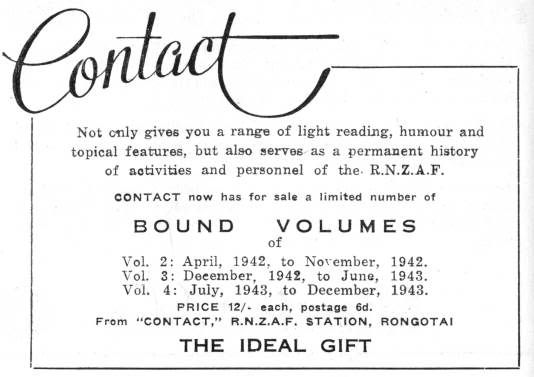
Contact was enjoyed by civilians as much as airmen, and the boys of the Air Training Corps were regular readers. It became something of the Reader's Digest of the Air Force, being passed around the crewrooms and mess halls, and then posted on to the boys abroad.
The final issue of the magazine was printed in December 1945, completing a total of eight volumes over four years and ten months. In the September 1952 the magazine was restarted after being adopted by the Royal New Zealand Air Force Association as their official journal, but not for too long a period. However for me it is the wartime ones that hold the most charm and interest.
A final word in that last issue of December 1945, it reads "When, dear reader, in later years you wish to recall some of the grave or gay times you have experienced in the RNZAF or the associations which you have had with the Service, go to "Contact" - it will always be waiting for you."
And this is why I choose to celebrate Contact here on this website. Some may argue that the Contact team contributed little to the war effort. I see it that they not only provided a boost to morale for those at home and a comfort from New Zealand to those abroad, but they have contributed directly to the culture and spirit of the wartime RNZAF. And furthermore, they're recorded that wonderful culture and spirit for future generations, like myself, to tap into.
CONTACT POSTWAR
Contact was revived in 1952, this time as "The Official Organ of the Air Force Association (Inc.)".
Beginning in September 1952 with Volume 1, No. 1 (New Series), the magazine virtually carried on where it had left off in December 1945. Little had changed in style, and many of the original Contact team members were involved in recreating the old magazine.
The Contact offices were now based at 164 The Terrace, Wellington, and the printer was Geo. W. Slade Ltd of Wellington. The cover of the first issue featured an evocative painting by Maurice Conly that commemorated the Battle of Britain, marking the battle's 12th Anniversary. Also making a return to print was Egbert the Erk, reprinted from an earlier wartime issue. The major noticeable difference in the more modern form were mentions and photos of jets and postwar aircraft, plus articles about NZ'ers in the Korean War. Contact continued till at least 1955, but at this time I have no firm date for when it ended. if anyone can supply further details of the 1950's Contacts I'd like to hear. I have the September 1952 issue and will more add details of that issue soon.
CONTACT TODAY
Today issues of the magazine are rare, but not impossible to find. They fetch around NZ$15 to $30 apiece on the second hand market, a nice mark up on the 1942-45 price of a shilling. There are collectors around, mostly in New Zealand, with the ambition of completing their collection with every last issue. I am one of these collectors.
I can highly recommend to you the late Maurice Conly's book Send For The Artist, which he wrote with Sqn Ldr Paul Harrison. It was published just before Maurice's death in 1997, and it details his life and his art, from RNZAF to designing most of New Zealand's stamps and coins till his death. The book has been a great resource of information for this webpage.
I hope that the above and the following information will give you a little more insight into this wonderful magazine, which was not just a passing amusement of the 1940's but has gone on to become a wonderful time capsule of the social history of the RNZAF, and a real classic. Here's a few more details of certain items.........
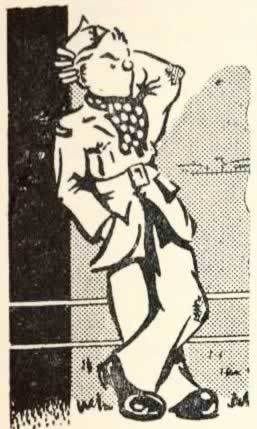
Above: Egbert the Erk doing his usual - skiving
One of the regular contributors to the humour section of Contact was a young airmen called Egbert the Erk, or more officially known as AC2 Egbert Eaglesoup (Serial No NZ39.303). He was of course a fictional comedy character, who was stationed at RNZAF Station Harhar (location unknown).
Each month he'd write a report on what had been bugging him lately. Lots of things bugged him, he was always in trouble for something or other. One person he was in trouble with often was RNZAF Station Harhar's SWO, Sgt Arnold J. Nigglepuss, who was the typical Station Warrant Officer. Here is an excerpt from one of Egbert's articles in which he describes his first visit to the home of Nigglepuss:
I had no difficulty in finding Niggy's house. On the Gate was a notice, "Beware of the Voice." I pressed a button and instead of a bell there was a siren. I heard someone yell, "Feet on the Floor" and then the door opened. Not since I was a tiny lad have I seen such a large woman. She was more than comfortably attired in a pink battledress with three rows of medals pinned on it. I was about to mumble something, when she opened her mouth and roared: "Good evening. One Pause Two."
I picked myself off the path and staggered back to the door. Holding on to a verandah post, I continued the conversation to learn that this very large and loud person was no one but Mrs Pixie Nigglepuss, D.A.M. (Distinguished Axewoman's Medal).
"Arnold's in the backyard playing "At the Halt on the Left Form Close Column of Flights" with the kids, but you can come in and sign the Arrivals and Departures Book."
....The story goes on....
A few minutes later Niggy turned up followed at intervals of five paces by members of his brood. "Family Halt. Family will advance, left turn. There were fifteen of them, all the same age and height. They all wore uniforms ranging from Boy Scouts to the Auxiliary of the Junior Women's Auxiliary Auxiliaries. Following the order, "Family to your meal dismiss ," we entered the dining room or No 4 Mess.
And the humour rolled on. It is as funny today as it was over 60 years ago - so long as you speak Air Force, otherwise you may not get what the heck it's about.As well as this trip to the SWO's home, Egbert would have all sorts of adventures from a parachute jump to rewriting the drill book for an RNZAF Station Harhar Wing Parade, to attempting to once and for all discover whether WAAF should be pronounced Woff or Waff, only to discover that it may be Warf.
There were other characters in Egbert's tales, including the Station CO, Wing Commander Wishbone, and also Nigglepuss's trusted spy, LAC H. Himmlersnoop.
The true author of these humorous tales sadly never seems to have been revealed. Whoever he or she was, they certainly had a great sense of humour and a keen eye for what went on around an Air Force Station.
Another regular 'fictional' contributor to Contact was Wendy The WAAF. These tales were written by WAAF, Mrs Doris McLean, who only identified herself in Contact by her serial number, W.2126, but her real identity was revealed in the June 1943 issue after many letters asking who she was.
These stories saw a young member of the Women's Auxiliary Air Force (WAAF), namely Wendy the WAAF, move from job to job in each episode of her Air Force career. Wendy was obviously a member of that trade known as 'Aircrafthand, General Duties' because she moved about the station from section to section, telling the story of her brief stays in each different trade regularly in Contact. Of course a few of the stories were more about other issues in Wendy's life, rather than her starting a new job. And some issues had more than one adventure too.
Interestingly the same author (WAL D.McLean, W.2126), also wrote another regular WAAF column called Diary of a W.A.A.F. These are a more serious look at life in the Woman's Auxiliary Air Force. We'll cover this column a little later. McLean was previously on the staff of the New Zealand Woman's Weekly.
Other Spin-Offs from Contact
Flights and Fancies
By A.R. Grimwood
In 1943 a sort of spin-off from Contact magazine was created, in the form of a book called "Flights and Fancies".
It was written by regular Contact contributor and the Contact unit's former CO, Flight-Lieutenant Andrew Robertson Grimwood. He may have moved on from leading the magazine's team but he was still involved as a contributor of articles and stories, and often wrote for Contact under the pen-name of Ropata Kirimuwutu (the Maori version of his English name).
Also collaborating with Grimwood on Flights and Fancies was Leading Aircraftman Oriwa Tahupotiki Hadden, one of the magazine's regular cartoonists. His humorous cartoons were always signed simple "ORIWA".
A third Contact connection came in the form of the painting on the dustjacket cover, it was painted by LAC Maurice Conly, Contact's artist. The painting depicted a Mosquito fighter dispatching a German aircraft, a painting that had already appeared on the cover of the July 1943 issue of Contact.
Published by Hutcheson, Bowman & Johnson Limited of Wellington in 1943, the book contains a series of short stories by Grimwood. The foreword was written in December 1943 by the Air Secretary, Mr Tom A. Barrow. In this foreword Barrow explains that the author had penned the short stories over a period of two years, and some had already appeared in Contact, whilst others were being published for the first time.
There is quite a range of emotions within the book, from humorous tales to the more dramatic and sentimental. But all reflect life in the wartime Royal New Zealand Air Force and dealt with situations that Airmen and WAAFs on stations right across New Zealand and beyond were experiencing in their real service lives.
"ORIWA" adds a touch of humour, satire and some patriotism with his cartoons book-ending each story. Again these were largely reruns of cartoons that had already featured within the pages of Contact.
So in essence this excellent and quite collectable book is something of a compendium of Contact stories with a little extra as well. It makes an excellent addition to any collection of Contact magazines
For Contact collectors I shall attempt to add a little detail so that the stories within can be matched to issues. This will hopefully become more full with time.
The following is a scan of the review published in Contact magazine itself of the book:
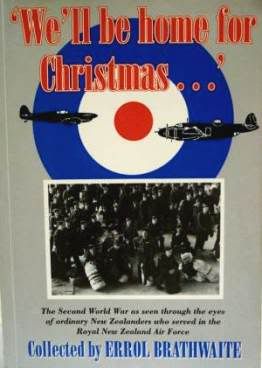
I'll Be Home For Christmas
By Errol Braithwaite
Though not perhaps a direct spin-off from the magazine, this excellent book must be mentioned here. The late Errol Braithwaite was an Air Gunner on Ventura bombers in the Pacific during the Second World War. He began his writing career in 1959 with the novel 'Fear In The Night', a gripping fictional account of an RNZAF Ventura crew who come down on a strip in enemy Japanese territory and must repair their engine and escape before the enemy catches them.
From there he went on to pen many books on the history of New Zealand, including some on the aviation history of this country. In particular of interest is his 1994 book "We'll be Home For Christmas". The book was a compilation of stories and memories from across a wide spectrum, lifted from books and magazines and memoirs. All were tied together with the common thread of being about the social history of the wartime RNZAF.
Among the passages reprinted from various autobiographies and original works by Errol himself (including fascinating pieces from his own wartime diary), there are several stories from Contact. He obviously went through many issues and selected some of the best. It was this book that first got me interested in the magazine and sparked my desire to collect the originals. I wasn't disappointed.
This popular book is in most good NZ libraries and can be picked up readily second hand, especially on the internet. Check out Abebooks.com or Tademe.co.nz
Sources For The Above History of Contact
- Send For The Artist by Paul Harrison and Maurice Conly, 1997
- RNZAF Golden Anniversary Souvenir Booklet - edited by Ross Ewing, 1987
- Contact Magazine - Various Issues, 1941-1945
- And many thanks go to Rod Mackenzie for his most appreciated assistance
- Flights and Fancies by AR Grimwood, 1943
- I'll Be Home For Christmas by Errol Braithwaite
- Dictionary of New Zealand Biography for Leo White
